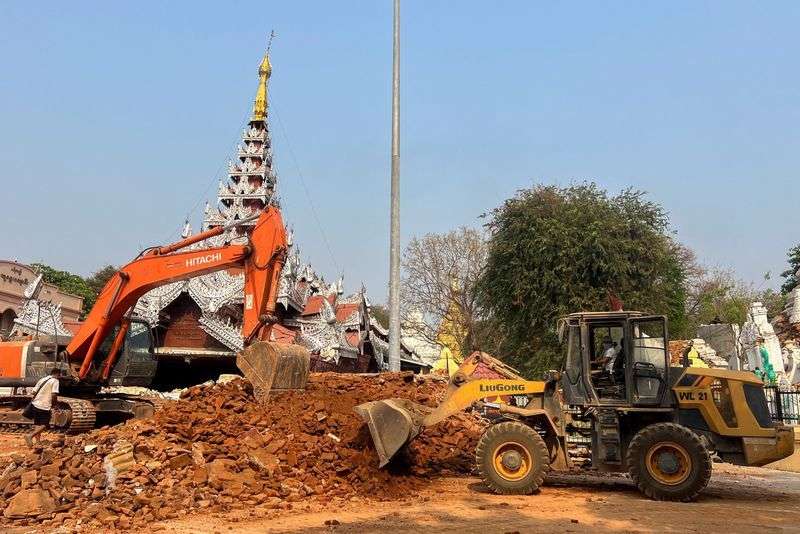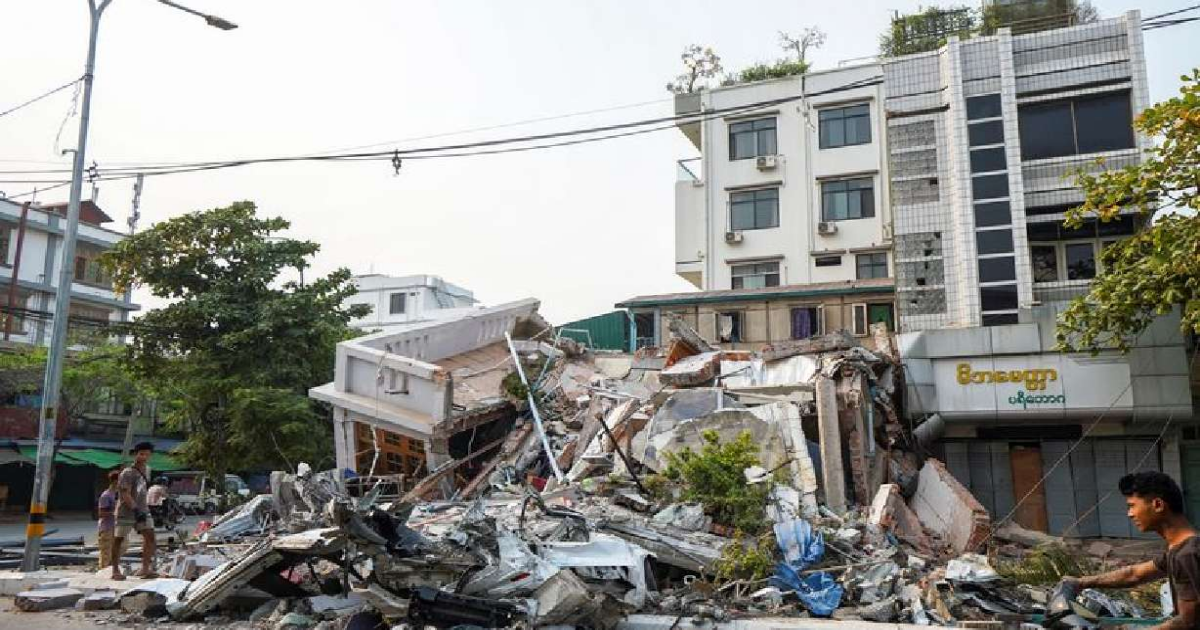Estimated read time: 5-6 minutes
BANGKOK — Signs of life were detected in the ruins of a skyscraper in Bangkok on Monday as efforts intensified to find people trapped three days after a massive earthquake in Southeast Asia that killed at least 2,000.
Scanning machines and sniffer dogs were deployed at the unfinished skyscraper and Bangkok’s Deputy Gov. Tavida Kamolvej said rescuers were urgently working out how to access an area where signs of life had been detected three days after the quake.
Realistic chances of survival diminish after 72 hours, she said, adding, “We have to speed up. We’re not going to stop even after 72 hours.”
In central Myanmar, rescuers freed four people, including a pregnant woman and a girl, from collapsed buildings in the city of Mandalay near the epicentre of Friday’s 7.7-magnitude earthquake, China’s Xinhua news agency reported.
Chinese rescue workers in red helmets carried one survivor, wrapped in a thermal blanket, through heaps of shattered concrete and twisted metal at an apartment building in Mandalay, China’s state broadcaster CCTV showed.
Drone footage of the city showed a huge, multistory building pancaked into layers of concrete, but some gilded temples were still standing.
Civil war in Myanmar, where a military junta seized power in a coup in 2021, was complicating efforts to reach those injured and made homeless by the Southeast Asian nation’s biggest quake in a century.
“Access to all victims is an issue … given the conflict situation. There are a lot of security issues to access some areas across the front lines in particular,” Arnaud de Baecque, resident representative of the International Committee of the Red Cross in Myanmar, told Reuters.
One survivor in Mandalay said that after rescue workers pulled him out of the rubble of his restaurant, he had rented a bulldozer with his own money to try to find the body of one of his workers and make the building safe for his neighbors.
One rebel group said Myanmar’s ruling military was still conducting airstrikes on villages in the aftermath of the quake, and Singapore’s foreign minister called for an immediate ceasefire to help relief efforts.

A person operates machinery following a strong earthquake, in Mandalay, Myanmar, Monday. (Photo: Reuters)
Search goes on at collapsed Bangkok building
In the Thai capital Bangkok, rescuers pulled out another body from the rubble of the unfinished skyscraper that collapsed in the quake, bringing the death toll from the building collapse to 12, with a total of 19 dead across Thailand and 75 still missing at the building site.
Initial tests showed that some steel samples collected from the site of the collapsed building were substandard, Thai industry ministry officials said. The government has launched an investigation into the cause of the collapse.
“We will have to collect more samples and conduct more tests once we can,” official Nontichai Likitaporn told a press conference.
In Myanmar, state media said the death toll had reached 2,065 with more than 3,900 injured and over 270 missing and that the military government had declared a week-long mourning period beginning on Monday.
The Wall Street Journal, citing the junta, reported the death toll had reached 2,028 in Myanmar, while the opposition National Unity Government, which includes remnants of the government ousted in 2021, put the toll at 2,418 as of Monday. Chinese state media said three Chinese nationals were among the dead.
Reuters could not immediately confirm the new death tolls. Media access has been restricted in the country since the junta took power. Junta chief General Min Aung Hlaing warned at the weekend that the number of fatalities could rise.

A collapsed bridge is pictured after a strong earthquake, near its epicenter, in Sagaing, Myanmar, Monday. (Photo: Reuters)
Relief efforts
The opposition appealed to countries to deliver aid directly to earthquake victims, saying there was a risk the junta could divert or obstruct humanitarian assistance.
“We are in a race against time to save lives,” the National Unity Government said in a statement. “Any obstruction to these efforts will have devastating consequences.”
A spokesperson for the junta was not immediately available to comment.
China, India and Thailand are among Myanmar’s neighbours that have sent relief materials and teams, along with aid and personnel from Malaysia, Singapore and Russia.

Chinese rescue workers stand at the site of a collapsed building, in the aftermath of a strong earthquake, in Mandalay, Myanmar, Monday. (Photo: Reuters)
“It doesn’t matter how long we work. The most important thing is that we can bring hope to the local people,” said Yue Xin, head of the China Search and Rescue Team that pulled people out of the rubble in Mandalay, Xinhua reported.
The United Nations said it was rushing relief supplies to survivors in central Myanmar.
“Our teams in Mandalay are joining efforts to scale up the humanitarian response despite going through the trauma themselves,” said Noriko Takagi, the U.N. refugee agency’s representative in Myanmar.
The United States pledged $2 million in aid “through Myanmar-based humanitarian assistance organizations.” It said in a statement that an emergency response team from USAID is deploying to Myanmar.
“The earthquake has laid bare the deeper vulnerabilities facing Myanmar’s people and underscored the need for sustained international attention to the broader crisis,” said U.N. Special Envoy on Myanmar Julie Bishop, calling for access to all areas for aid groups and condemning what she said were continuing military operations.
Critical infrastructure — including bridges, highways, airports and railways — across the country of 55 million is damaged, slowing humanitarian efforts while the conflict that has battered the economy, displaced over 3.5 million people and debilitated the health system, rages on.
“We see devastated communities across the country in Mandalay and (the capital) Naypyidaw in particular … People are still sleeping outside, can’t access their homes, so they don’t have capacity to cook their meals, said de Baecque of the International Committee of the Red Cross.
“All the health structures that have been damaged … are not delivering what they were doing in terms of health care and have a difficulty to absorb extra needs.”
Contributing: Wa Lone, Chayut Setboonsarng and Michelle Nichols
